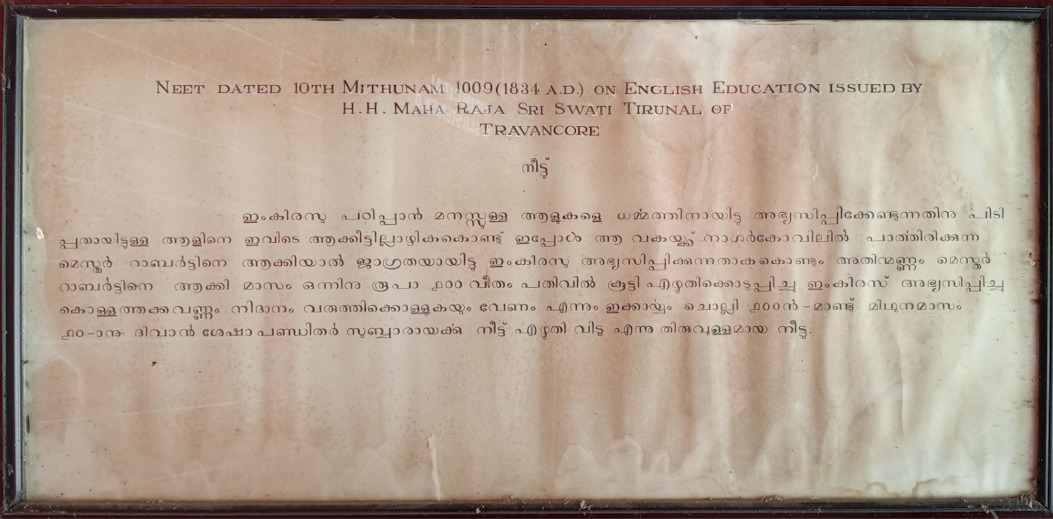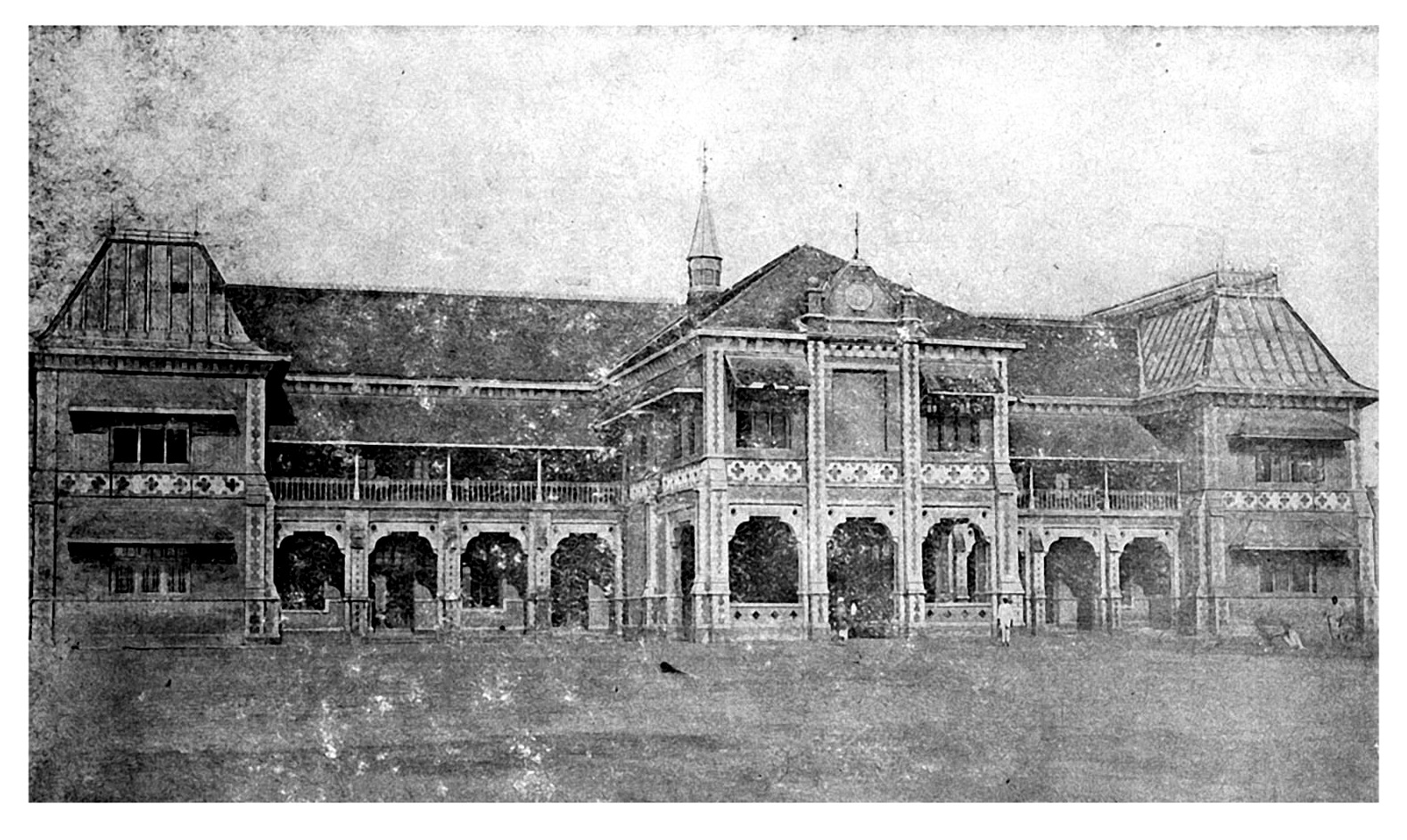A Short History of University College, Thiruvananthapuram

The institution, now called the University College, was founded in the year 1834 by the Government of Travancore during the reign of his Highness Sri Swathi Thirunal Rama Varma, one of the most illustrious rulers of the former State of Travancore, celebrated for his devotion and great contributions to art and culture.
The Maharaja had occasion to visit a school that was imparting instruction in English at Nagarcoil under the auspices of the London Mission Society. He was impressed by the school and the quality of the education given there and was convinced that the new type of school held out great prospects for the people of the State. Shortly thereafter he invited Mr. Roberts who was in-charge of the school at Nagarcoil to come to Thiruvananthapuram and start a similar school there. The educationist who was an Englishman, agreed and a new school was started in 1834. It was private institution, but the State Government contributed the prescribed fees for 80 pupils who thereby got free tuition.  The classes were conducted in an old building located about half a mile to the south of the University College, on the premises where the Ayurveda College stands today. In less than a year Government took over the school and assumed full responsibility for its management. Mr. Roberts was appointed Headmaster and the school came to be known as ‘The Raja’s Free School’. In the following year the institution was moved to a new building constructed for the purpose on the premises where the University College is now located. The school continued as a free institution till 1863-64. Those were days when education of the western type was being newly introduced in India and the Raja’s Free School was one of the earliest institutions in South India established under the auspices of the Government for imparting instruction to the children of the State. It attracted pupils from all parts of Travancore and many of its alumini rose to high positions in the public life of the State and distinguished themselves in may fields of cultural activity.
The classes were conducted in an old building located about half a mile to the south of the University College, on the premises where the Ayurveda College stands today. In less than a year Government took over the school and assumed full responsibility for its management. Mr. Roberts was appointed Headmaster and the school came to be known as ‘The Raja’s Free School’. In the following year the institution was moved to a new building constructed for the purpose on the premises where the University College is now located. The school continued as a free institution till 1863-64. Those were days when education of the western type was being newly introduced in India and the Raja’s Free School was one of the earliest institutions in South India established under the auspices of the Government for imparting instruction to the children of the State. It attracted pupils from all parts of Travancore and many of its alumini rose to high positions in the public life of the State and distinguished themselves in may fields of cultural activity.
In 1866, during the reign of His Highness Sri Ayilyam Thirunal Rama Varma Maharaja of Travancore, it was decided that facilities for higher education should also be provided by the Government and the Raja’s Scholl was raised to the status of a College affiliated to the University of Madras. It was named H.H. The Maharaja’s College, though it still had the original school attached to it. Mr. John Ross, an inspiring teacher whom many a Travancore an of the previous generation still remembers with reverence and affection, was the first Principal. Courses leading to the first examination in Arts of the Madras University were started. A spacious building for housing the college was constructed in 1870. It was a two-storeyed structure and has lasted to this day, forming the central block of the main building of the University College, which bears the bell tower and the ornamental G.I. roofing at the two ends. In laying the foundation stone of the building, His highness the Maharaja Ayilyam Thirunal said: –
“ I consider this a grand occasion. I laying the foundation stone for a college we are in fact imparting strength and durability to a system of public education of a high order, which cannot fail to exercise a most important influence on the rising generation and on generations yet unborn.
It is gratifying to me to reflect that English education struck early root in Travancore, that under favourable auspices, it has attained satisfactory growth and that already, pressing on the material limits provided for its by my venerated predecessor, it now calls for enlarged accommodation.
Such a call, it is superfluous for me to say, will at all times be responded to by the Sate with the utmost alacrity. To the numerous pupils I see assembled on this auspicious occasion I will only say: Pursue your various studies with the utmost devotion and perseverance,; show yourselves worthily of the anxious care bestowed on you by your country for cultivated intelligence and, even over following into other countries, prove yourselves formidable yet friendly rivals to those whom other colleges send abroad. By such a course you will win credit for yourselves and honour for your country.”
The College was affiliated for the B.A. Degree course to the University of Madras, first in Philosophy, in 1884. Mr. Robert Harvey who succeeded Mr. John Ross as Principal was the first Professor of Philosophy. B.A. courses in Mathematics, Chemistry, History, Physics and Sanskrit and Dravidian Languages followed in quick succession. A galaxy of distinguished Principals, Indian and English, guided the fortunes of the institution during its early years and the “Old Colleges” as it came to be fondly referred to by its alumini and the public acquired a pre-eminent position in the affections of the people of Travancore. IT was considered an honour and privilege to be a student of the college and to be on its staff. The pick of the intelligentsia of the State was attracted towards it. Among the great scholars who served the institution and won high credit and great reputation forfeit and for themselves by their single minded devotion to the pursuit of higher learning the name of the late. A.R. Raja Raja Varma, Grammarian and Poet deserves special mention. He has left a deep impression on the language and the culture of the land. He was Professor of Sanskrit and Dravidian Languages from 1910 to 1918 and also acted as Principal from 1915 to 1916.
The B.A. honours courses in English and History were started in 1914. Provision for the study of Natural Science (Biology) in the Intermediated Course was made in 1922. The school section of the institution continued to function in the same premises till 1919. In October of that year the school was shifted to a new building at Vanchiyoor and the whole of the old building was given over to the College. The strength of the college, that year, was 561. By 1923 it arose to 837 and there was great pressure for additional accommodation. Therefore in 1924 the Government decided to separate the Arts and Science Departments, This step, which is known as the bifurcations’ was given effect to at the beginning of the academic year 1924-25. The new institutions that came into being as result of the bifurcation were called H.H. The Maharaja’s College of Science and H.H. The Maharaja’s College of Arts. The later was housed in a new three storeyed building about a mile away at Thaikad. After the birucation, the Sceience College was affiliated for the B.A. pass course in Botany in 1924 for the B.A. Honours course in Mathematics in 1925 and for the B.A. pass course in Zoology in 1931. In the Arts College in B.A. Honours Course in Malayalam was started in 1935 and the B.A Honours Course in Sanskrit in 1939. The B.A. Course in Philosophy, though it was the first to be started in the old College, had to be discontinued for many years, as sufficient number of students was not forthcoming. It was however, re-started in 1925 in the Arts College. The strength of the Arts College in 1935-36 was 447 and that of the Science College 937.
The two Colleges grew from strength to strength and became the premier institutions of higher education in the State. Members of the teaching staff of the language sections used to be transferred from the college to the other and this along contributed to the maintenance of some contact between the two. The bifurcation of the old college brought about a certain dichotomy of the spirit between the humanities and sciences and both disciplines suffered there from. “The richness or corporate life springs from the university of its elements”. This was realized by the authorities and in 1942 the two institutions were amalgamated. The reunited College was called the University College. Subsequently the Intermediate section was separated from it (in 1949) and the College became a Post Intermediate Institution. M.Sc. Courses in Physics, Chemistry and Economics in June 1953. B.A. Courses in politics and Hindi were started in June 1951. B.Sc. Courses in Geology was started in June 1953. The M.A Courses in Hindi was started in 1957. As new courses were started, facilities for advanced research came to be provided both in the humanities ad the sciences.
In 1957, State Government took over the Management of the College; a special scheme for coaching students for the U.P.S.C. Examination (I.A.S) was in the College in October 1961. With a view to giving opportunities of higher standard education to employed personnel, as Evening College was started in the College in June 1965.
The College celebrated its Centenary in a grand manner in July 1969 Dr. S. Radhakrishnan, the then President of India, inaugurated the celebrations.
The B.Sc. (Special) course was started in 1966 in Mathematics, Physics, Chemistry, Botany and Zoology. But these courses were discontinued in 1969 when the Kerala University abolished them.
The Government vide G.O (Ms.) No. 62/93/H. Edn. dated 14-5-1993, decided to shift the Graduate courses to another campus in a phased manner. Accordingly, the First year classes of the Eleven B.A, Degree courses were shifted to the new buildings for the Graduate Section at Kariavattom during 1993-94 and those of the B.Sc. Degree during 1994.95. The final year classes of the B.A ad the Second and final year classes of the B.Sc. courses will ceased to function in the College by the end of the academic year 1994-95 and 1995-96 respectively.
The Government has decided to re-introduce the degree courses and to shift III year B.Sc. Classes from University College Graduate Section, Kariavattom to this college from the academic year 1996-97 onwards.
MPhil courses in 13 disciplines have been newly started from the academic year 1994-95. The University College now conducts 21 Post Graduate programmes and 18 Graduate programmes with about 278 members of staff (Teaching and Non-teaching) and over 3164 students on its roll.
This College has been recognised by the University as a Research Centre for M. Phil and Ph.D Degree in twelve disciplines.

